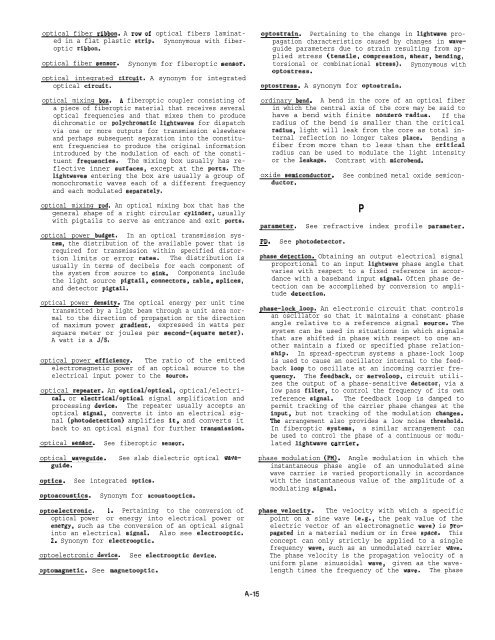FIBEROPTIC SENSOR TECHNOLOGY HANDBOOK
FIBEROPTIC SENSOR TECHNOLOGY HANDBOOK
FIBEROPTIC SENSOR TECHNOLOGY HANDBOOK
Create successful ePaper yourself
Turn your PDF publications into a flip-book with our unique Google optimized e-Paper software.
optical fiber ribbon. A rowof optical fibers laminated<br />
in a flat plastic strip. Synonymous with fiberoptic<br />
ribbon.<br />
optical fiber sensor.<br />
Synonym for fiberoptic sensor.<br />
optical integrated circuit. A synonym for integrated<br />
optical circuit.<br />
optical mixing box. A fiberoptic coupler consisting of<br />
a piece of fiberoptic material that receives several<br />
optical frequencies and that mixes them to produce<br />
dichromatic or polychrometic lightwaves for dispatch<br />
via one or more outputs for transmission elsewhere<br />
and perhaps subsequent separation into the constituent<br />
frequencies to produce the original information<br />
introduced by the modulation of each of the constituent<br />
frequencies. The mixing box usually has reflective<br />
inner surfaces, except at the ports. The<br />
lightwaves entering the box are usually a group of<br />
monochromatic waves each of a different frequency<br />
and each modulated separately.<br />
optical mixing rod. An optical mixing box that has the<br />
general shape of a right circular cylinder, usually<br />
with pigtails to serve as entrance and exit ports.<br />
optical power budget. In an optical transmission system,<br />
the distribution of the available power that is<br />
required for transmission within specified distortion<br />
limits or error rates. The distribution is<br />
usually in terms of decibels for each component of<br />
the system from source to sink. Components include<br />
the light source pigtail, connectors, cable, splices,<br />
and detector pigtail.<br />
optical power density. The optical energy per unit time<br />
transmitted by a light beam through a unit area normal<br />
to the direction of propagation or the direction<br />
of maximum power gradient, expressed in watts per<br />
square meter or joules per second-(square meter).<br />
A watt is a J/S.<br />
optical power efficiency. The ratio of the emitted<br />
electromagnetic power of an optical source to the<br />
electrical input power to the aource.<br />
optical repeater. An optical/optical, optical/electrical,<br />
or electricalloptical signal amplification and<br />
processing device. The repeater usually accepts an<br />
optical signal, converts it into an electrical signal<br />
(photodetection) amplifies it, and converts it<br />
back to an optical signal for further transmission.<br />
optical sensor.<br />
See slab dielectric optical wave-<br />
optical waveguide.<br />
guide.<br />
optics.<br />
optoacoustics.<br />
See fiberoptic sensor.<br />
See integrated optics.<br />
Synonym for acoustooptics.<br />
optoelectronic. 1. Pertaining to the conversion of<br />
optical power or energy into electrical power or<br />
energy, such as the conversion of an optical signal<br />
into an electrical signal. Also see electrooptic.<br />
2. Synonym for electrooptic.<br />
optoelectronic device.<br />
optomagnetic. See magnetooptic.<br />
See electrooptic device,<br />
optostrain. Pertaining to the change in lightwave propagation<br />
characteristics caused by changes in waveguide<br />
parameters due to strain resulting from applied<br />
stress (tensile, compression, shear, bending,<br />
torsional or combinational stress). Synonymous with<br />
optostress.<br />
optostress. A synonym for optostrain.<br />
ordinary bend. A bend in the core of an optical fiber<br />
in which the central axis of the core may be said to<br />
have a bend with finite nonzero radius. If the<br />
radius of the bend is smaller than the critical<br />
radius, light will leak from the core as total internal<br />
reflection no longer takes place. Bending a<br />
fiber from more than to less than the critical<br />
radius can be used to modulate the light intensity<br />
or the leakage. Contrast with microbend.<br />
See combined metal oxide semicon-<br />
oxide semiconductor.<br />
ductor.<br />
parameter.<br />
— PD.<br />
P<br />
See refractive index profile parameter.<br />
See photodetector.<br />
phase detection. Obtaining an output electrical signal<br />
proportional to an input lightwave phase angle that<br />
varies with respect to a fixed reference in accordance<br />
with a baseband input signal. Often phase detection<br />
can be accomplished by conversion to amplitude<br />
detection.<br />
?hase-lock loop. An electronic circuit that controls<br />
an oscillator so that it maintains a constant phase<br />
angle relative to a reference signal source. The<br />
system can be used in situations in which signals<br />
that are shifted in phase with respect to one another<br />
maintain a fixed or specified phase relationship.<br />
In spread-spectrum systems a phase-lock loop<br />
is used to cause an oscillator internal to the feedback<br />
loop to oscillate at an incoming carrier frequency.<br />
The feedback, or servoloop, circuit utilizes<br />
the output of a phase-sensitive detector, via a<br />
low pass filter, to control the frequency of its own<br />
reference signal. The feedback loop is damped to<br />
permit tracking of the carrier phase changes at the<br />
input, but not tracking of the modulation changes.<br />
The arrangement also provides a low noise threshold.<br />
In fiberoptic systems, a similar arrangement can<br />
be used to control the phase of a continuous or modulated<br />
lightwave carrier.<br />
phase modulation (PM). Angle modulation in which the<br />
instantaneous phase angle of an unmodulated sine<br />
wave carrier is varied proportionally in accordance<br />
with the instantaneous value of the amplitude of a<br />
modulating signal.<br />
phase velocity. The velocity with which a specific<br />
point on a sine wave (e.g., the peak value of the<br />
electric vector of an electromagnetic wave) is propagated<br />
in a material medium or in free space. This<br />
concept can only strictly be applied to a single<br />
frequency wave, such as an unmodulated carrier wave.<br />
The phase velocity is the propagation velocity of a<br />
uniform plane sinusoidal wave, given as the wavelength<br />
times the frequency of the wave. The phase<br />
A-15
















